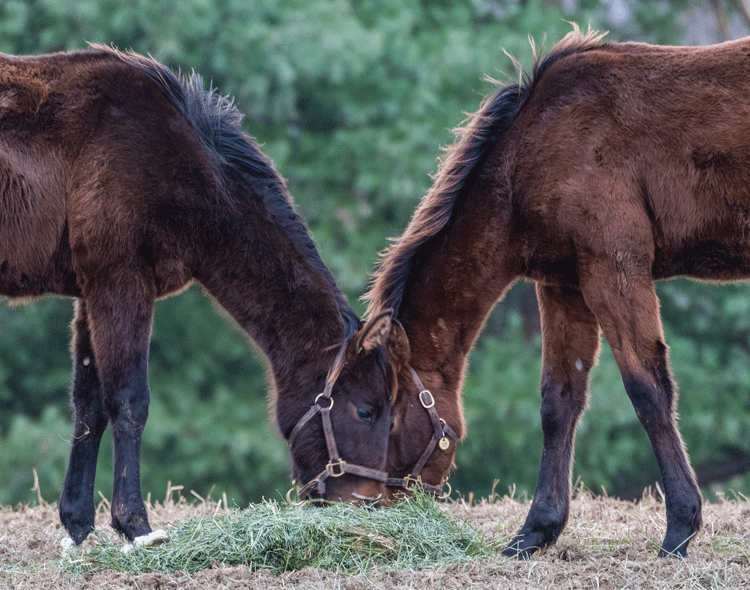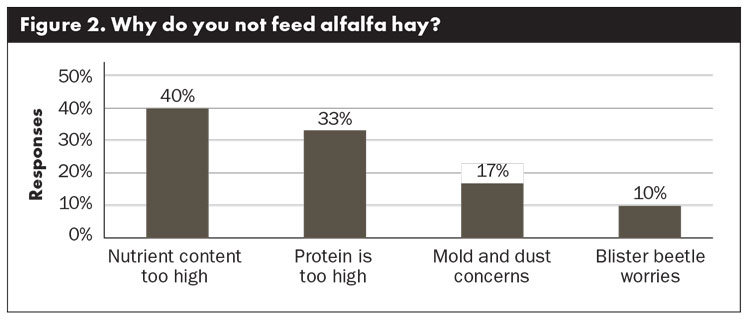Horse owners have their say on hay |
| By Krista Lea |
|
|
|
The author is a research analyst and horse pasture evaluation program coordinator with the University of Kentucky.  Alfalfa hay has its place in a horse diet, just not all horse diets. In a recent survey of horse owners, 48% said alfalfa hay was an excellent source of nutrition while 73% said it was too high in protein or overall nutrients (Figures 1 and 2). These results represent conflicting opinions. Hay producers across the U.S. have experienced a similar disconnect when marketing to the horse industry. As a horse owner and a forage agronomist at the University of Kentucky, I’d like to shed some light on how to market hay to horse owners and tap into this lucrative but fickle market. The truth is that horses come in a variety of sizes, shapes, and uses, and with this much variation comes differences in nutritional needs as well as owner expectations. To successfully reach this clientele, you have to satisfy both. From a forage quality perspective, horses aren’t all that different than cattle. Energy is typically the most limiting factor, and we need to try to target higher energy hay with horses that require a higher energy diet. Similar to a lactating cow, a lactating horse or a horse doing heavy work is going to require energy and nutrient-dense hay such as alfalfa. But a mature, idle horse will require far less energy. Gain can mean pain One significant difference in cattle and horses is the ease at which horses can become over-conditioned. Overfeeding horses can lead to obesity and a slew of metabolic disorders that can be career- or life-ending. So, horse owners are just as concerned with meeting nutritional needs as they are exceeding nutritional needs. Unlike most other agricultural species, gain is not always a good thing, and appropriate hay will, in most cases, maintain body condition instead of increase it. For horses, high-quality hay is considered to be free of weeds, dust, and mold, and when fed at sufficient amounts to match intake requirements (usually 1.5% to 2.5% of body weight), meets the nutritional needs of the horse without exceeding it. The idea of an “idle” animal is also somewhat unique to horses. Most cattle farmers are encouraged to cull any animals that aren’t being productive. But because a horses’ value isn’t in their pound of flesh, bigger isn’t better. A horses value is in their genetics, their performance or the work they do. And in some cases, their value is intrinsic; the joy and friendship they bring far outweigh any monetary value they might have.  Figure 1: Why do you feed alfalfa hay?
Beyond nutritional needs, how do horse owners select hay? The same survey that found the conflicting data presented earlier also revealed a few other things that might be beneficial in answering this question. The survey study, which was funded by National Alfalfa and Forage Alliance checkoff dollars, was conducted by researchers at the University of Kentucky in the Departments of Animal and Food Sciences and Plant and Soil Sciences with the goal of better understanding hay-buying preferences of horse owners. The first group of questions asked whether or not horse owners like to feed alfalfa (or alfalfa mixed hay) and why. Many said they both liked to feed it and didn’t like to feed it, which was probably due to different needs for different horses. For example, I currently have four horses in my barn consuming alfalfa hay: two yearling fillies actively growing, one broodmare near parturition, and one old, very picky retired mare. The rest of my barn, consisting of mostly retired geldings, maintain their body weight quite well on what most hay producers would call low-quality hay — straight grass, slightly over mature, and stemmy. I, too, would be one to answer: Yes, I prefer to feed alfalfa hay, and no, I don’t prefer to feed it. It depends on the horse. More than price In another question, horse owners were asked to rank what factors are most important to them when purchasing hay. The factors listed included bale size, quality analysis, cost, dealer reputation, and availability of delivery. Cost ranked first, which was not surprising. But the second most important factor was dealer reputation. It was important to know that friends were satisfied with their hay purchase. Horse owners want to be sure that price reflects the quality of the product, and that the seller is willing to stand behind their hay if there is a problem. All of these were more important factors than a guaranteed analysis of the hay. Like many aspects of agriculture, word of mouth is the ultimate advertisement. Every hay supplier that I purchase from simply says, “If they don’t eat it, I’ll come back and get it.” And they have.  Figure 2: Why do you not feed alfalfa hay?
Small bales preferred The third most important factor was bale size. While many hay producers are moving to larger bales for handling and trucking ease, they also need to remember that the end horse user could be a small woman, feeding one or two horses, who would prefer a 40-pound bale she can pick up over a more economical 75-pound bale. Often, there isn’t the space or equipment to even consider 3x4x8-foot large square bale. Horse owners were also asked where they get their hay-buying information. Of the 10 choices they were given, university personnel ranked first. Second was the hay supplier, which was somewhat surprising. This means that horse owners value the hay supplier’s guidance more than most other sources of information, including extension publications, their veterinarian, and the internet. Understanding the needs of the clients and their horses gives hay suppliers a tremendous advantage because horse owners clearly value their knowledge and guidance. It’s advantageous for hay suppliers to get to know their clients, which is an easy task because horse owners love to talk about their horses. Most horse owners aren’t nutritionists, agronomists, or money managers. They know their horses and desire the correct feed for them. If hay suppliers and producers take the time to get to know their horse clients (human and horse alike), provide them with the quality of hay they require in a package they can handle, and stand by that product, they will be rewarded with a loyal clientele willing to pay a premium for hay that suits their needs. • This article appeared in the March 2023 issue of Hay & Forage Grower on pages 10-11. Not a subscriber? Click to get the print magazine. |
